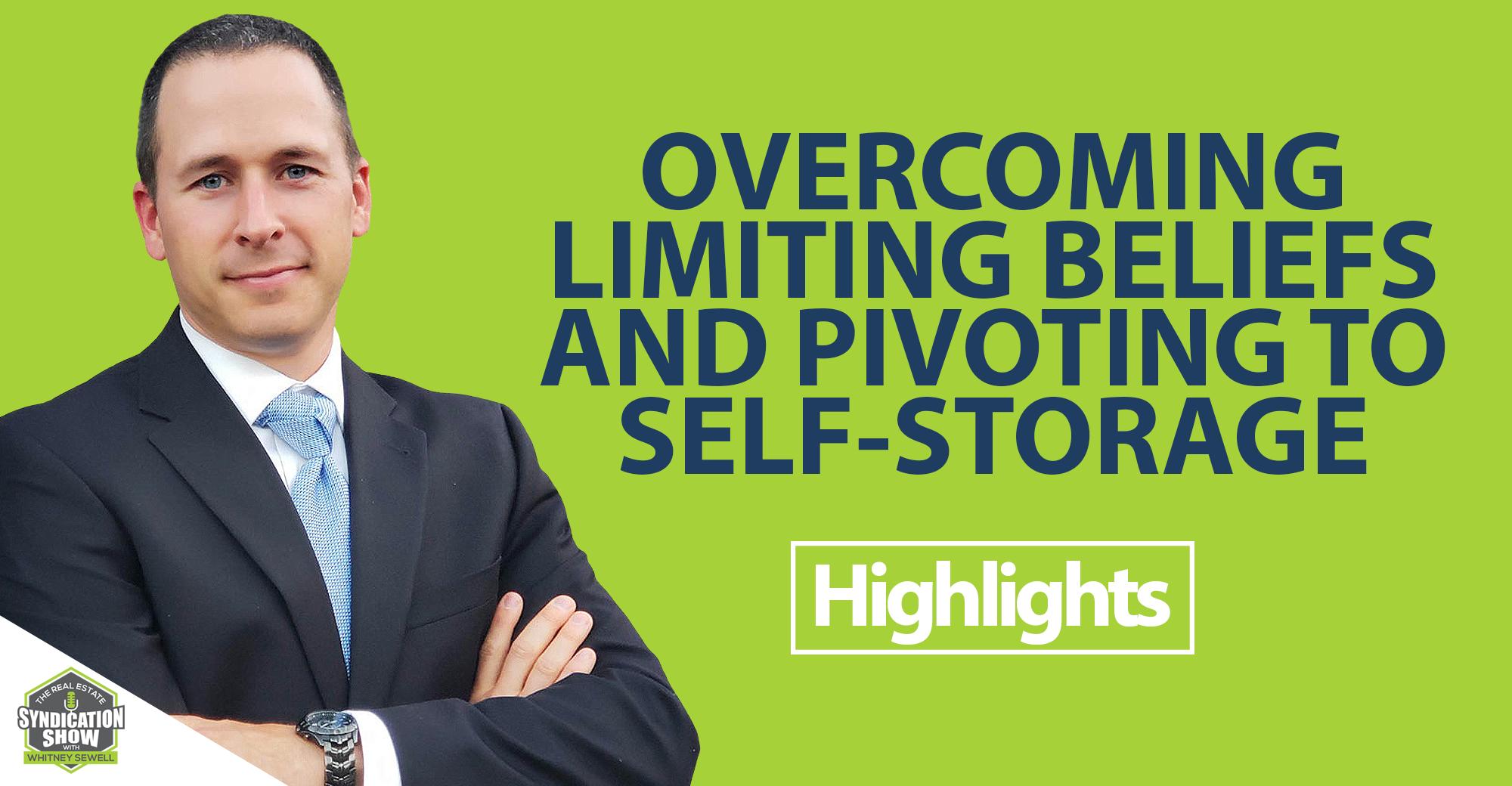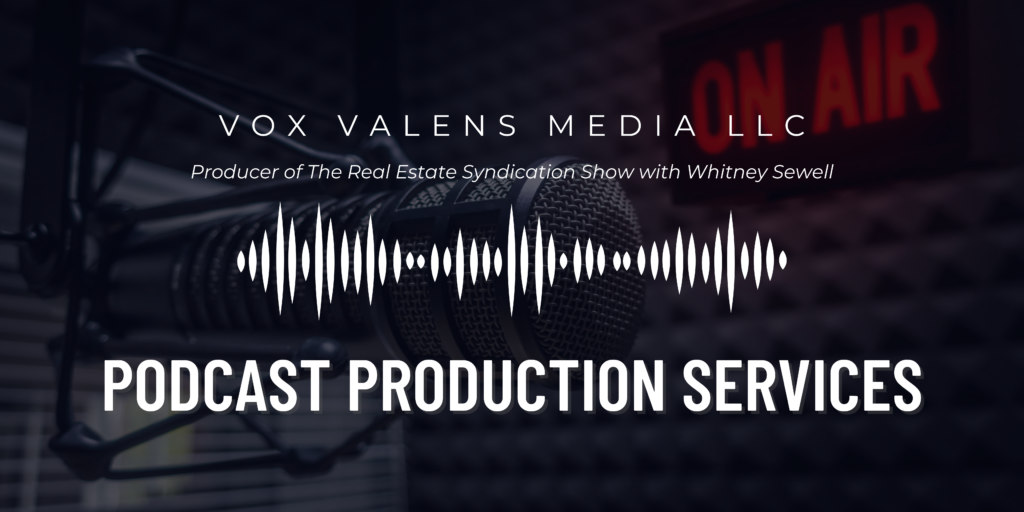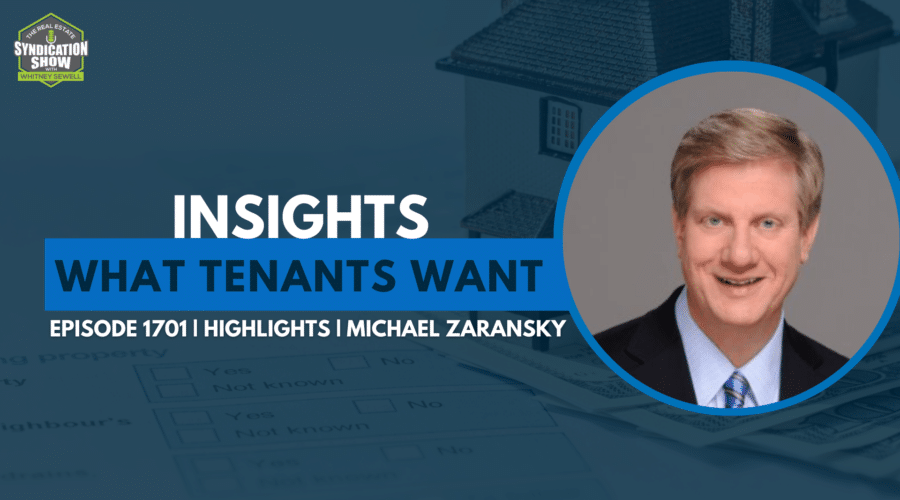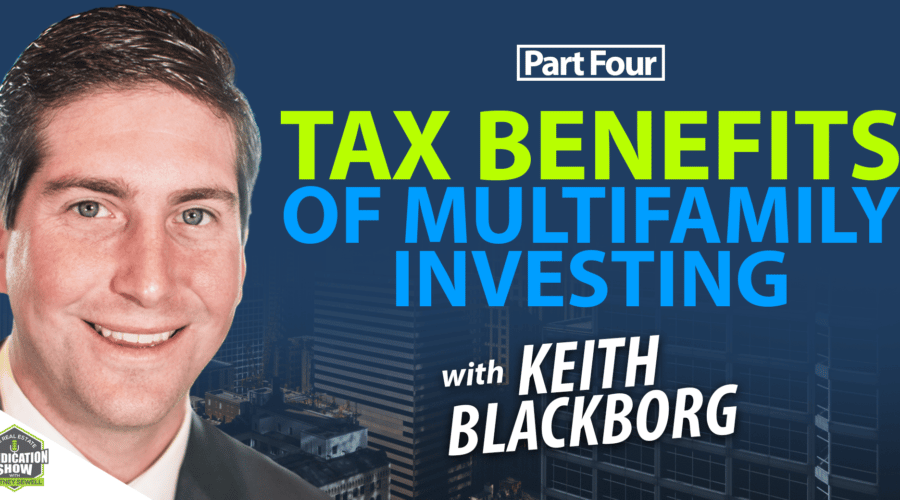Oftentimes, your own personal limiting beliefs can stand in the way of you attaining success. For each of us, they are unique to our own situation but it is vital that you pivot your mindset, and start believing in yourself. Our guests today went from a full-time W2 job and took the leap of faith to go into real estate full-time — in the self-storage sphere.
Our Gracious Sponsor
Vox Valens MediaThe team that produces The Real Estate Syndication Show is now available to produce podcasts for you! View our list of services and rates or book a call to know more!
Watch the episode here:
Listen to the podcast here:
In this episode, we welcome guest Zach Quick, Zach is a Christian, husband, father, and self-storage investor located in Northwest Arkansas. Zach and his wife built up a residential portfolio of 28 units before pivoting into self-storage full-time. They now own and operate 7 facilities and over 300,000 square feet in the midwest. Today we dive into why Zach and his wife decided to go into self-storage, what it is like working with his spouse when he knew it was time to leave his full-time job, how self-storage may be resilient to downturns, and so much more.
RK says a negative event such as the pandemic created positive actions in self-storage. RK’s advice to investors – be ready to learn from others and understand their points of view. RK is one of the most recognized personal “brands” in the self-storage industry. Tune in now!
Key Points From This Episode:
- Zach shares more about his story.
- The breaking point that helped Zach pivot from single-family/ residential to self-storage.
- What it is like working together as a team with his wife.
- When Zach knew it was time to leave his former job and move full-time into real estate.
- Why Zach went with self-storage over multifamily or any other asset class.
- Limiting beliefs and how they’ve made the syndication process difficult for Zach.
- RK talks about how the pandemic affected the self-storage industry.
- What RK learned over the past year and what has changed in the industry because of the global health crisis?
- RK shares the changes in underwriting and the amount of reserves in the self-storage industry amid the pandemic.
- RK shares how many self-storage facilities are in the U.S.
- RK’s predictions in the self-storage industry over the next six to twelve months.
Tweet This!
“[I think] the hardest part, [of syndication] are your limiting beliefs.” — Zach Quick
“[To be successful,] I think having a good relationship with God and having a supportive wife and optimism are three huge ingredients.” — Zach Quick
“Fortunately, self-storage has been recession and event resilient for years and years.” — RK Kliebenstein
“It (self-storage) is a demand-driven business. And when you have high demand, the prices go up. And when you have surplus inventory, the prices come down.” — RK Kliebenstein
Links Mentioned in Today’s Episode:
About Zach Quick
Zach is a Christian, husband, father, and self-storage investor located in Northwest Arkansas. Zach and his wife built up a residential portfolio of 28 units before pivoting into self-storage full-time. They now own and operate 7 facilities and over 300,000 square feet in the midwest.
About RK Kliebenstein
RK is the Leader of Coast-To-Coast, a trusted resource in self-storage since 1999, and is a Product Consultant to Aggregate Intelligence, Inc, creators of the StorTrack brand and data products for self-storage industry. Previously he has served as the head of acquisitions for Metro Storage, Extra Space, U-Store-It (now Cubesmart), Stor All, and VP of Operations for StorageOne. RK has experience in acquiring, developing, due diligence, strategic planning/execution, operating/managing, disposition, and financing. He has worked internationally and domestically. He is currently developing both self-storage and RV/Boat/Vehicle storage projects.
As an individual RK Kliebenstein is one of the most recognized personal “brands” in the self-storage industry. RK followed his passion to write and is co-author of the award-winning self-storage book “HOW TO INVEST IN SELF-STORAGE”, as well as “HOW TO MAKE MONEY IN SELF-STORAGE”, and the sequel “HOW TO MAKE MORE MONEY IN SELF-STORAGE”. A world-class communicator, author, and corporate leader, RK has had countless articles published and is considered to be a pre-eminent authority on self-storage, mobile storage, and vehicle storage. He is currently working on a book outside the industry: “Power and the Five P’s of Success” (working title).
RK has a passion for golf, and also builds the only 82 m.p.h. golf cart with air conditioning! RK has been active in the Ministry of Men for nearly 30 years, helping men and being helped in growing personal relationships with the Trinity.
Full Transcript
EPISODE 1337
[INTRODUCTION]
0:00:00.0
Whitney Sewell (WS): This is your Daily Real Estate Syndication Show and I’m your host, Whitney Sewell. Today is a Highlights show that’s packed with value from different guests around a specific topic.
Don’t forget to like and subscribe but also go to LifeBridgeCapital.com where you can sign up to start investing in real estate today. I hope you enjoy the show!
[INTERVIEW 1]
WS: Today our guest is Zach Quick. Thanks for being on the show Zach.
Zach Quick (ZQ): Thank you for having me Whitney. I am a big fan of the show and happy to be here.
WS: Yeah, I’m grateful to have you on. I appreciate you being a listener as well. A little about Zach, he is a Christian, a husband, a father, and self-storage owner located in Northwest, Arkansas. Zach and his wife built up a residential portfolio of 28 units before feeling compelled to 100% pivot into self-storage. They have since sold all their residential portfolio and own and operate seven storage facilities, consisting of over 300,000 square feet in the Midwest.
Zach, thank you again for your time being on the show. I am looking forward to getting into this story, I think there is a lot of listeners that are going to be able to relate to what you have done or maybe they are in that moment where you know, trying to think about should they make that pivot, should they take that leap. You know it’s a big step, it’s encouraging. You know, your wife is involved as well, I am sure there is listeners that can relate to that.
Give us a little more about who you are and let’s dive into your story a little bit so you can help the listeners.
ZQ: Sure, yeah and thank you again. So yeah, I had always known, you know in college that I wanted to be involved in investing or small business ownership in some way, shape, or form and out of college, I did the stock market thing for a while and then saved up enough money that my wife and I, we wanted to buy a house hack that was kind of our entry point so to speak, but we were moving for a job at the time and it was kind of a tight timeline —
And so, a duplex didn’t really work out but we found a garage apartment, and it kind of just checked all the boxes, worked really well. I mean that was kind of our entry into it and we ended up basically from that point over the next two to three years just kind of full-fledge going into residential small houses up to a small 12-unit apartment — to where we had 28 full units and kind of that 12 unit was the last one, got it rehab, filled up and kind of just felt stuck —
Partially because we were somewhat out of money and then twofold, didn’t really, and some of it was some limiting beliefs, which we can touch on but just kind of couldn’t really figure out what was next. I think, in my mind, I thought, “Well, we’ll sell this 12 unit and kind of move into maybe a 30 unit,” or whatnot and so anyways, I was on a family vacation and my dad was driving actually and I looked out the window and there were these bright blue self-storage doors.
And I’ve never really looked at self-storage in any way, shape, or form, and I literally feel like God was saying, “Hey, why don’t you look into this a little bit more?” And so that’s what we did and I just did a lot of research and started filling out what we’re looking for, listing to anything that we could look at and reading anything that we get our hands on and then – and eventually once we sold that 12 unit, we actually 1031 into a storage property and that was August of 2018.
And so that was our first one and then fast forward to now, we own and operate seven storage facilities in Missouri and Arkansas and we’ve sold all of our residential stuff. So, and I – storage kind of spoke to me and us, and I don’t say that to come on here and just say storage is better than anything else or anything like that. I think it is just more of kind of finding your niche and how you can really lean into that and kind of put some wind behind your sails, so to speak. So that is kind of us in a nutshell.
WS: No, that’s awesome. I just appreciate you sharing about just your path because I think it is the way many people get into the syndication business or get into commercial real estate. They start with single-family or duplexes or those things, even house hacking. You know, it’s interesting just your all’s desire to get into the business and doing whatever it takes, even finding a garage apartment that you know, worked for you all to make that happen.
And then starting with some single-family up to a 12 unit, you know I think you said but feeling stuck. You know let’s talk about that, I mean you felt stuck, you know, out of money and probably trying to figure out you know, “Well, how are we going to buy the next deal?” You know? Can you just talk about that a little bit? The thoughts there and how you did get to the next level, what was the breaking point that helped you to make it happen to move past that or to pivot from single-family then you know if that was the time that that happened?
ZQ: Sure, and yeah, so a couple of things, and I kind of touched on those limiting beliefs at the time is so that 28 units was all just my wife and I. You know, she was a teacher. I had a decent W2 job and we were good savers and basically, we were just plowing anything and everything we could to keep growing but again obviously, you know you kind of run out of your own money at a certain point and so — a couple of shifts in that after we had brought our first storage facility —
You know, commercial real estate is not cheap that we wanted to keep growing and in order to do that, you know you have to be open to partners whether that be strategic partners, financial partners, all of the above. And so, that’s one of the ways that have obviously helped us grow is you know, someone who wants to be involved that may not have the time or skillset to do so but maybe have some money lying around to do so but so that, it was a big part of it and also just not limiting ourselves.
I think that you know, I had this idea of it being such like a linear process. I kind of mentioned like selling that 12 unit and then that will naturally go into like a 20 or 30 unit or something along those lines, where, you know, even then I would – there were times where like maybe a deal would be slightly bigger than I was comfortable with and I would just kind of turn away from it.
Whereas now, I’ve come to realize and obviously it is an ongoing process too. But now, you know if a deal is bigger than me, so to speak, like it doesn’t mean anything. There is plenty of pieces of the pie to go around, so to speak, and that doesn’t mean that there are other people that wouldn’t be willing to help you do those things. So hopefully that answers I guess partially some of the beliefs that we were stuck on.
WS: Yeah, for sure. No doubt about it. I think all of us have limiting beliefs all the time, you know especially in the beginning. You just cannot see yourself doing something bigger than that single family home or that duplex. It is really hard to get past that, it was for me and I even had people that I had trusted who were amazing entrepreneurs, you know that would say, “Now, wait a minute Whitney, you know most people start with more single-family home. And most people don’t typically jump into the syndication business that fast and without years of single-family experience or things like that.”
Did you receive advice like that and have to kind of say somehow, “Well, thank you but this is what we’re doing,” and then still make it happen?
ZQ: Yeah and just a lot of I don’t know, kind of explaining the thought process —because on the surface and I say this very blessed, you know at 28 units that’s more than a lot of people will do but we just desired for more and thought that we were capable of more and so kind of just explaining that basically we’re going to try and start over, or start in a completely – and a new area that we really didn’t know a ton about in order to try and reach it, an end goal that we could get there.
So yes, not luckily we try and surround ourselves with supportive people but definitely, you still have to kind of find yourself explaining why you are doing what looks like a negative step or you are setting yourself up to fall on your face kind of thing as well so.
WS: Can you speak to just working together as a team with your spouse? You know, I know there’s a lot of people who are maybe trying to get their spouse on board or trying to figure out, you know how they can work together in this business. The audience knows my wife has just been just an – just amazingly supportive just through this entire process. I could not have done it without her. She is not passionate about real estate however, she is passionate about supporting me and our mission, our why, you know all of those things, she is very passionate about —
And so I couldn’t have done it without her that’s for sure. You know can you just speak to what that looks like as far as you all doing this together and how that worked for you all?
ZQ: Yes and I echo so much about my wife what you just said about yours and that I am very lucky that she was willing to – you know I mean, we didn’t have the nicest cars or the nicest houses that we could afford and honestly right now, we’re living in a rental right now because we decided we wanted to move to a new area and all that requires basically buy-in from your spouse to do those kinds of things and so I am very lucky that she can –
She had the diligence and the foresight to see what we were building towards. So a lot of communication, which I was terrible at, at the beginning, it was kind of like, “Hey, I’m going to do this,” and “Hey wife, you’re coming along,” which is not a path that I would recommend in any way, shape or form. So, but I think now that you know, with a lot of open communication and praying and that essentially we are on the same page now.
I mean where neither of us are in a W2 anymore. So, she was a teacher up until this school year and then now she handles a lot of the bookkeeping and then also just keeping me in check. I like to go-go-go and I think that having someone that is a little bit more a rational voice at times to bounce ideas off of and not to shoot me down but to at least help me arrive at a better conclusion so to speak. So, a lot of trial and error but you know, just ultimately knowing that we do these things to hopefully at the end of it like look back on a lot of things.
Like with our spouses and say, “Look at this life that we built together” and so that’s something that I am really proud of her and us of where we’re at now and just continue to work at too.
WS: When did you know that it was time for not only you but you and her to leave your J-O-B’s, your positions, your jobs?
ZQ: Yeah, sure. So it is funny, for at least a handful of years I had always told her like, “If you feel called to like, you know that you didn’t want to teach anymore that you wanted to stay home with our daughter or like you could do that,” and we got – so I actually ended up leaving my job before her to kind of focus on storage more solely and so I left in June of last year and then she, I guess officially left in the end of last summer.
Sorry, the dates are kind of weird with COVID cutting – or sorry, I guess she officially left this past summer but they didn’t really teach past March but anyway, so it got to a point that I just felt – we felt comfortable enough that the trajectory and that we picked up enough momentum that frankly we were going to figure it out and you know, a lot of praying and then also figuring out that like on some level like if we fall on our face like we felt confident that we could get other jobs and that we would find a way to scrape and make it work so.
WS: Eventually you have to do it, right? Eventually, you just have to rip that Band-Aid off really and know that you are going to make it happen. You know there’s not an option to fail, right?
ZQ: And I think honestly, I would have passed on a deal or two that if I still had my job that I’ve reaped benefits for us just because there wasn’t that same sense of urgency or at least it felt like the same sense of urgency and I don’t mean like, you know an acquisition fear or anything like that because we weren’t syndicating but just that like this is a good deal, like you need to do it whereas like you know, you’re still comfortable with your job. So, you necessarily don’t have to do it kind of thing.
WS: So why self-storage over multi-family or any other asset class?
ZQ: Yeah, so I think for me probably one of the biggest things is I felt at ease and again, this is kind of where we’re at, at the time that self-storage felt a little bit more like a business to me and that there is a lot more moving parts daily that I kind of wanted to be more involved whereas and again, I’m simplifying but with an apartment, you know a lot of it you get them filled up and somewhat you are just hoping that they stay there for a year and that it’s not trashed.
Again, I am simplifying, but there’s a lot to me, a lot more levers that you can pull with rental increases, administration fees, insurance, selling boxes, and locks. So, to me there were just a lot more moving parts with storage and I think that that kind of just helps with some of the business backgrounds that I had and just wanting to be more involved in the day-to-day so to speak so.
WS: Zach, what’s been the hardest part of this process or for you to get to, you know commercial real estate and be successful?
ZQ: I think that and I am not sitting here as someone that has like conquered that beast because we all still have those voices in the back of our heads that said like, “Well, yeah. He can do this because he has more money” or he has this partner or this partner. Like you just have to be able to basically shut that out and determine that you are going to do something.
So, I would say kind of going over that hump but it is still a continual process to get you to where you want to go.
[INTERVIEW 2]
WS: Our guest is RK Kliebenstein . Thanks for being on the show, RK.
RK Kliebenstein: Thank you.
WS: RK is a leader of Coast to coast, a trusted resource in self-storage since 1999, and is a product consultant at … Intelligence Incorporated, creators of the store track brand and data products for the self-storage industry. As an individual, RK is one of the most recognized personal brands in the self-storage industry, a world-class communicator, author and corporate leader, RK has had countless articles published and is considered to be a permanent authority on self-storage, mobile storage and vehicle storage.
RK welcome to the show, it’s encouraging having somebody like yourself with the level of experience in the business, and especially what’s happened over the last year, I’d love to hear, does your take on where the self-storage industry is currently, you kinda catch us up a little bit on that, and we will dive into some specifics…
RK: Sure, Whitney, thanks. It’s interesting how the pandemic has affected so many different sectors, and we’ve seen strengthen areas like RV sales, recreational things that we can do on our own in our home, more things that don’t require as much public interface, and the other side of the coin has been those sectors that have been hit really, really hard by a hospitality retail, just a number of those that have really had a challenge in dealing with the pandemic.
And challenging dealing with how consumers and business has responded to a pandemic. So a lot of people ask, Well, what about self-storage? We know what really happened in self-storage and how did it weather the storm… and fortunately, self-storage has been recession and event resilient for years and years and years, and we came through even TRA, the Tax Reform Act of 86 pretty well.
We came through Tech bus fairly well. The last great recession, we felt it, no question about it, our foreclosure rate has always been one of the lowest of any real estate asset class, and even during the great recession, we weathered that storm really, really well. We were quite uncertain as to what would happen with the pandemic, but once again, the self-storage has proven itself to be highly resilient to things that happen, it is certainly affected by it, but we rather the storm really, really well.
In the beginning of the pandemic, we saw those natural reactions where people were not opening their offices in coming to the offices, that slowed down the rental stream a bit, but just as that happened, we saw the college universities closed their dormitory, so any self-storage property that was near a university instead of getting that heavy traffic in the summertime when there’s a break, they got it immediately when they were moving out of the dorms, so we saw kind of a boost on our industry, right at the very, very beginning of the pandemic.
We did have some effect in the payment structures because people were delayed in making their payments, we were held by stays from the government in our ability to collect rents, those things affected us. But again, as soon as we started coming out of the pandemic from our stay-at-home orders and pretty space on openings, we immediately saw a robust refill of the activity that had been delayed and put on hold during the early part of the pandemic.
Occupancies rose. We got back into rent increases again, is it… As we were able to, there are some statutes that have had limitations on our rental rate increases, but we immediately saw that and then Whitney, the really interesting part was our business pre-pandemic, the industry was really dealing difficulty with an over-building situation or over-saturation in many of the major metropolitan areas, while the pandemic, a lot of those projects on hold, and so what it did is it actually boosted the industry again,
because we saw some of the starts in construction get delayed or even completely terminated, we saw the lenders tighten up a bit. So again, a really negative event created positive actions in salt storage, we also are very dependent in many cases on the RV, in the boat industry, the marine industry, because we store those vehicles any time there’s one that is delivered, it has to be parked somewhere, and so with the great increase in interest in RVs and boats, we saw that product fill up most of the vacant spaces that were out there.
And so it has been a blessing in many ways, we certainly understand the devastation it caused and the challenges that have come with the pandemic, but as an industry, we were very, very blessed to come through it and be stronger on this side of the pandemic, and we were on the front side of it.
WS: That’s awesome. I appreciate that update and just hearing really how self-storage been so recession-resistant or even resistant as you mentioned to lowest foreclosure numbers, but what are some things that are maybe some challenges that happened for self-storage, but what did you learn and what changed because of that?
RK: A couple of things from an operational perspective, many of the larger operators, the institutional operators, they were either on the precipice of, or they actually had online rental capability through their websites, and the pandemic just put them in a position to fully execute, and a couple of the large operators had that ready to roll out, they were actually in beta testing, they had just kind of showed the project well.
They immediately were able to deploy and that made a huge difference in the speed and the velocity they were able to capture rentals coming into contactless rental. So that was an interesting part was that the technology actually now have kind of caught up with usage and vice versa, but it also was for some of the independent owner-operators who had thought about contact list rentals and how they could do leasing online to actually figure out the solution that worked best for them and deploy that solution as well.
So across the board, we saw some interesting challenges in how do we handle our offices being closed and then deploying solutions right away that we’re there, and unfortunately for us, the vendors in our industry and technology already had those solutions ready to go, they were easy to roll out, all you had to do as a scribe to them and roll out. So that was an interesting part.
I think the biggest challenge that we saw has been in supply chain and in the cost of raw materials, because much of a salt storage property, even if it’s a multi-story climate control, there’s a lot of red iron in there and a lot of steel, so we’re very, very dependent upon steel and Whitney, as you may know, most of the steel in the United States comes through China, and so being wholly dependent on that source, it really caused an interruption on our supply chain.
We already had felt from 18 months ago, the effects of the tariffs, so we had already had a huge increase in pricing for our base product to build with anyway, and then as the pandemic hit, we just saw the difficulty in getting materials really play out, fortunately, the larger firms that provide steel for the self-storage industry, particularly the door manufacturers and the hallway manufacturers where the greatest amount enrolled cold steel is used and fabricated for sale story.
They already had existing supply contracts, and so they were able to continue delivery because they already had those allocations coming to them, they had already picked those prices those that were smart, way over bought, and then found out that they had actually way under bought at the end of the day, because those that needed that supply immediately absorb any inventory that was really out there, we were somewhat affected by construction with labor, as you know self-storage construction is fairly labor-intensive.
And so erecting all of those hallways and door systems is kind of a specialty trade, and so we did see some issues with being able to attract particularly new workers to the sector as we were trying to adapt to the sale of the inventory that was out there, but again is… And I don’t need to over-optimize self-storage because we certainly have all kinds of challenges as well, but again…
We weather do really, really well because we were able to now employ people who had been taken out of the hospitality or the food services industry, ’cause a lot of that labor is not highly skilled, and so we were able to put them to work in our industry. That really made a huge difference as well. Probably the biggest challenge that we’ve had, Whitney, has been in the payment part of our business.
We had several legislations that occurred that actually put a stay on rental payments, they capped our late charges, there was legislation out there that didn’t allow us to get to the rent increases maybe that we had anticipated, all of those payment issues are still prevalent today to some extent, much lesser extent than they were called in June, July, August of the pandemic. But now as we’re seeing openings and we’re really beginning to see the economy flow back up again.
Those were minimized at the end of the day, but we did definitely feel the effect of people not making their payments in storage, a great number of our customers, our guests or tenants are on auto pay, it automatically goes to their credit card, and so a typical self-storage operation that is He institutionally run, we’ll have somewhere between 40% and 50% of their payments on auto pay, so they were unaffected by it, they just continued to roll right through it. As though nothing had happened. So those were probably the biggest challenges that we faced.
WS: Were there any underwriting changes or maybe the amount of reserves that you all have, anything like that, that something like happens… It makes you think about it. How you’re moving forward? Any changes in those things?
RK: So great question, and yes, we did see, particularly in the death side of things, change in the underwriting relative to deserve coverages, moved up slightly. What really happened was a higher level of scrutiny on the projections for rent increases, self-storage is a really interesting business from the aspect of how manage our revenues, the most sophisticated operators, they set rental rates in self-storage to the exact same way you sell airline seats hotel rooms and car rentals.
It’s a demand-driven business, and when you have high demand, the prices go up, and when you have surplus inventory, the prices come down, and so what we saw was really that peaking as the recovery occurred, we definitely saw that they were able to move the rents up, but it was on a much delayed basis, those were probably some of the biggest challenges that we have, but the underwriters were saying, look, instead of projecting pet 15% increases for next year, we think those should be in the 2 to 3%.
They marginalize our upside, and for some projects that was gonna be problematic because they were counting on very high rental rate increases to get their projections to make return investment objectives.
WS: How me self-storage facilities are there in the US?
RK: That’s a number that it’s hard to quantify in some ways, because you have to define what is a self-storage property, do you consider 20 units in a corn field 50 miles out of Des Moines, Iowa? Do you count that one or do you just count those that are in major metropolitan areas, but that number is somewhere around 57,000 to 60,000 self-storage properties in the US.
So what that means is there are more self-storage properties in the US than there are McDonald’s, Wendy’s Burger King and Taco Bell restaurants combined, and most people just don’t realize how many self-storage properties there are in the United States, but once you need self-storage, you drive down the road and you just begin to see that they’re everywhere. It’s like, buying a new car, Whitney. You buy a car and you think nobody else has it, and then you drive down the road, everybody’s got the same color.
WS: Exactly right. No doubt about it. What about, RK, just moving forward, what do you see for the future of of self-storage, say over the next 6 to 12 months, anything in our market that you see happening that affects the way you all are operating?
RK: Well, I think they’re the biggest change that we’re going to see, again, not trying to be overly optimistic, but there has been a stall in deployment of capital in some of the other sectors, so for example, hospitality, not a lot of new stores were happening in hospitality money that had been set aside and ascribed to go to either existing purchases of hospitality or new construction stars, that money kinda went on hold, well, we’ve seen a lot of that flow towards self-storage.
The same thing for retail, we don’t know how the consumer is going to respond totally post-pandemic, are they still going to have their groceries delivered now that they’ve seen the convenience of it, and have used the benefits of it, or are they gonna wanna go squeeze the tomatoes and go to their retailers, so maybe it doesn’t have nearly as big of effect on retail, but certainly we look at sectors that have been affected office, for example, has it… That’s a great…
All that money that was flowing into office, that stopped because of the pandemic, a great portion of that has now flowed towards self-storage, so we’ve seen cap rates tighten even a little bit, we’ve seen high activity levels amongst very solid investors. Private equity is still chasing self-storage, just an amazing level is just an unbelievable how many calls we get from private equity looking to deploy capital and finding the self-storage because we weather the pandemic so well, and as an industry.
We’re getting better, better structured, we have more data today in our industry than we’ve ever had before, better data, more data, more sophisticated tools to analyze it, and so as a result of that, we’ve really seen the flow of money from other sectors now looking at self-storage, and quite frankly, our yields are pretty good, particularly in development. It’s not unusual to see an 8 to and 9% development yield.
We’re chasing IRS or development projects, Mateen still. So it’s very robust, and because of that strength, the challenge is that self-storage is very, very capital-intensive. A typical self-storage construction project is going to be leveraged somewhere in the 60% to 65% range, so a 10 million project means that you’re gonna need three and a half to 4 million dollars worth of capital to the other part of self-storage is…
It takes a very long time to get to stabilization, you’re going to be in the entitlement process somewhere between one and two years depending upon how many barriers to entry there are an entitlement. The construction process is anywhere from nine to 12 months, obviously in inclement weather areas, it takes longer because you have delays from construction because of weather, and then the Lisa process.
While you may become physically occupied somewhere between 24 and 30 months to get economically stabilized may take three to four years, depending on the size of the project. And how much competition there is. So those are the real challenges of self-storage, it’s very capital-intensive, it’s very management-intensive, it was once thought to be a no-brainer, but we’ve proven over and over again that you need sophisticated management and tools to properly manage self-storage.
And we’ve seen that level of intensity for capital means that any time that you have that much equity in a project, it puts pressure on their returns.
[END OF INTERVIEW]
[OUTRO]
Whitney Sewell: Thank you for being a loyal listener of The Real Estate Syndication Show. Please subscribe and like the show. Share with your friends so we can help them as well. Don’t forget to go to LifeBridgeCapital.com where you can sign up and start investing in real estate today. Have a blessed day!
[END]
Love the show? Subscribe, rate, review, and share!
Join the Real Estate Syndication Show Community:








